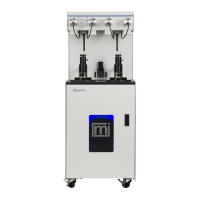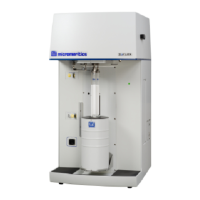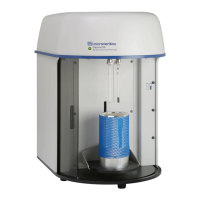ASAP 2460 Operator’s Manual Appendix F
246-42800-01 - Aug 2013 F-11
Model isotherms were calculated using the prescriptions of Tarazona for density dependent weighting
functions assuming 2D model of finite slit pores having a diameter-to-width aspect ratio of 6.
This model is particularly useful for microporous carbon materials. The reported pore size range is
from 3.5 to 250 Å.
N2 - Carbon Finite Pores, As=12, 2D-NLDFT
Ar - Carbon Finite Pores, As=12, 2D-NLDFT
Model isotherms were calculated using the same methods and assumptions that were used in the model
above except in this model, the aspect ratio is equal to 12.
These two finite pore models may be used as a research tool in conjunction with independent analyti-
cal techniques such as high-resolution transmission electron microscopy (HRTEM) and/or X-ray
diffraction (XRD) to obtain comprehensive information about the structure of studied carbon material
.
N2 - Carbon Cylinder, single-wall nanotube by NLDFT
Ar - Argon Cylinder, single-wall nanotube by NLDFT
Model isotherms were calculated using the prescriptions of Tarazona for density dependent weighting
functions and cylindrical pore geometry. The pore wall potential is described by the Lennard-Jones
potential of interaction between a gas molecule and the graphitic surface of an infinitely long cylinder.
Reference: Jacek Jagiello and James P. Olivier. “A simple two-dimensional NLDFT
model of gas adsorption in finite carbon pores. Application to pore
structure analysis.,” The Journal of Physical Chemistry C,
113(45):19382-19385, 2009.
Geometry Finite Slit
Substrate Carbon
Category: Porosity
Method: Nitrogen at 77 K; Argon at 87 K
Reference: See above reference.
Geometry Cylinder
Substrate Carbon
Category: Porosity
Method: Nitrogen at 77 K; Argon at 87 K
